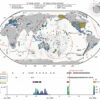If someone asked you what the worst year in human history was, what would you guess? 1347 CE was pretty bad. That’s the year the Black Death seriously hit Europe. Any of the years of the Holocaust, between 1941 and 1945. Or 1918, the year of the start of the flu pandemic that killed up to 100 million people – even the current pandemic pales still in comparison to that tragedy.
As it turns out, the suckiest of all was a year most people have probably never even thought about: 536 CE.
“It was the beginning of one of the worst periods to be alive, if not the worst year,” Harvard University archaeologist and medieval historian Michael McCormick told Science Magazine in 2018. His team’s paper on the subject doesn’t see signs of economic recovery until 640 CE.
536 was the 10th year of the reign of Byzantine emperor Justinian the Great, and nothing much was happening in the human sphere aside from regular boring skirmishes. No plagues (not yet, anyway), no unusually large genocides.
But something weird was happening in the sky: a mysterious, dusty fog appeared, blocking the Sun, causing temperatures to plunge and setting off years of around-the-world chaos – drought, crop failures, summertime snow in China, and widespread famine.
“And it came about during this year that a most dread portent took place,” wrote Byzantine historian Procopius, “For the sun gave forth its light without brightness, like the moon, during this whole year, and it seemed exceedingly like the sun in eclipse, for the beams it shed were not clear nor such as it is accustomed to shed.”
There’s evidence to suggest that catastrophic volcanic eruptions are the culprit, not just in ice cores from Antarctica and tree rings from Greenland, but in the effects of later volcanic events, which also caused short-term global cooling and devastating famine.
In 2018, a highly detailed ice core analysis of the Colle Gnifetti glacier on the border between Switzerland and Italy yielded up new information about the century of woe into which the world was plunged.
Ice cores are a fantastic archaeological resource, since permanent ice deposits build up gradually, through annual snowfall. This means that you can find the ice deposit for any given year and look at what was happening in the atmosphere.
In the year 536 CE, volcanic ash and debris – called tephra – was mixed in with the ice layer, indicating a large volcanic event. Greenland and Antarctic ice cores showed evidence of a second eruption in 540 CE, which would have prolonged the misery. And then in 541, the Justinian Plague cropped up, and everything just went from bad to worse.
But in around 640 CE, the researchers noticed a sign of renewal in the ice: lead. Yeah, no, lead pollution isn’t the best thing ever. It’s what that lead pollution means: that humans had started mining and smelting silver from lead ore.

Then there was another spike in 660 CE, and another in 695 CE. Humans were minting silver coins.
“This unambiguously shows that, alongside any residual pool of Roman bullion and imported metal, new mining facilitated the production of the last post-Roman gold coins – debased with increasing amounts of silver – and the new silver coinages that replaced them,” the researchers wrote in their paper.
“The high-resolution ice-core record offers a new and independent chronology for renewed silver production in the early medieval west.”
In short, the economy was recovering – and it only took a hundred or so years. It’s almost enough to make one terrified of volcanoes or something.
Interestingly, the ice core also shows a collapse in lead pollution in around 1349 to 1353. This coincides exactly with the chronology of the Black Death, and the researchers used it as a marker to determine that they were estimating the correct years for the volcanic markers and pollution spikes.
Pretty interesting what you can find out from a piece of old frozen water, hey?
The team’s research was published in the journal Antiquity.
A version of this article was originally published in November 2018.



